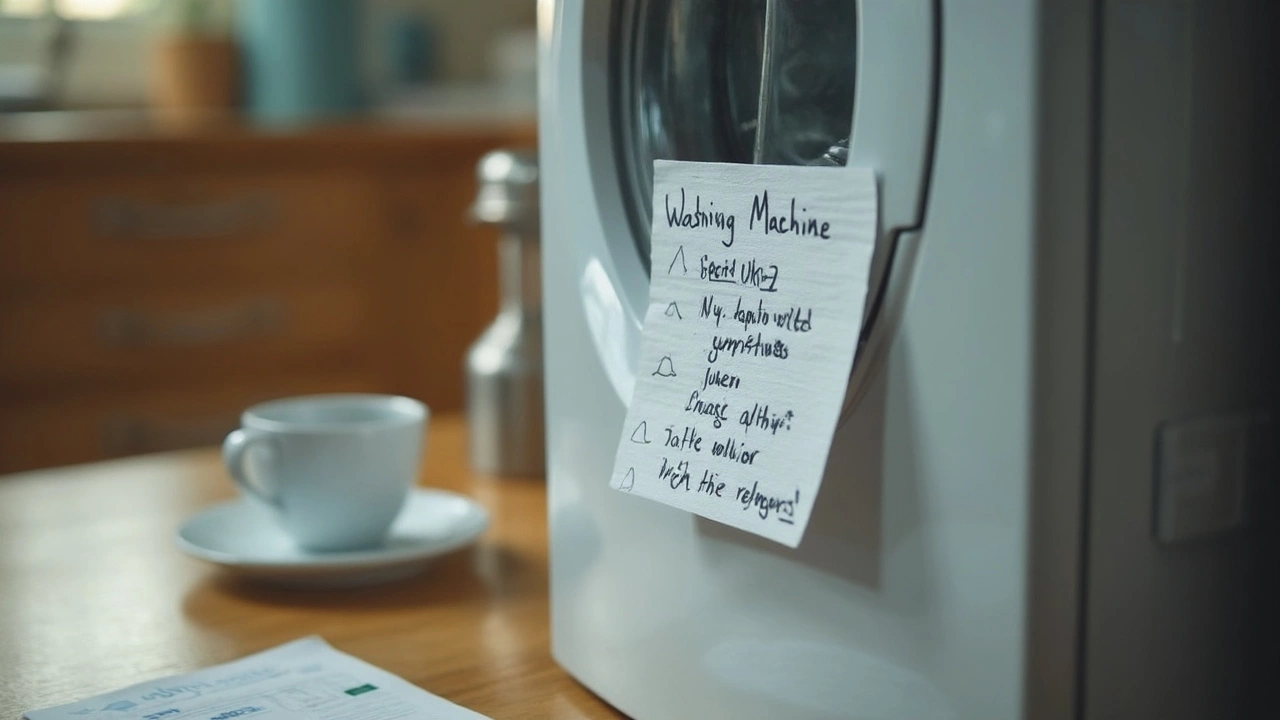Ever tried to get your dishwasher fixed and ended up playing twenty questions about what it looks like, what it does, and what weird noise it’s making? Most techs will tell you: the fastest way to fix an appliance is by knowing exactly which one they’re dealing with. If you want your service call to go smoothly, nailing the description is your secret weapon.
Start with the basics. Always look for the brand and model number. Don’t assume the repair person knows what “the silver fridge with big handles” means, because those words could fit about fifty models. Find the sticker or plate—sometimes inside the door or on the back. Snap a photo if you need to. That’s what most pros wish people would do.
Then, talk about what’s actually wrong. Is your dryer not spinning, or is it running but no heat? Does your oven turn on but not get hot enough? These details matter—a lot. Describing the problem as clearly as you can (even weird sounds—like “banging,” “whining,” or “clicking”) can point techs to the right part faster and save everyone a headache.
- Why Details Matter When Describing Appliances
- The Key Info Every Service Call Needs
- Avoiding Common Mistakes and Confusion
- Pro Tips for Faster, Better Repairs
Why Details Matter When Describing Appliances
When you call for appliance service, the real magic happens before the technician even steps through your door. It’s all about how well you describe appliance issues up front. Even one missing detail can send things sideways fast. One major appliance brand, Whirlpool, found that about 30% of wasted service trips come from a lack of complete information on the initial call. That’s not just annoying—it’s expensive for everyone involved.
The right info up front lets techs bring the correct parts, tools, or even order replacement items ahead of time. Imagine telling a technician only that your “fridge doesn’t work,” versus “my Samsung RF28HMEDBSR, serial number ending 2945, is showing error code 39 and not cooling.” The first description might mean two trips. The second can mean a first-time fix.
Here’s a quick hit list on why it really matters:
- Speeds up repairs by avoiding those annoying, drawn-out visits.
- Cuts down the chance of bringing the wrong parts (which happens more than you’d think).
- Helps the service team spot if an issue is common for your exact appliance model—so they can often diagnose it before they arrive.
- Saves you money by reducing unnecessary labor or extra trips.
Check out this simple breakdown of how providing full details affects repair outcomes, based on industry data:
| Info Given on Call | Chance of First-Trip Fix | Average Wait Time (Days) |
|---|---|---|
| Accurate model & problem | 82% | 1.2 |
| Vague/general info | 51% | 3.9 |
Clear communication makes you the hero of your own appliance story. The small step of giving solid, detailed info keeps everyone’s day running smoother.
The Key Info Every Service Call Needs
If you want the technician to show up ready, clear details make it way easier for everyone. You don’t need to be an expert—there’s just a short list of things your service call should always include.
- Brand and Model Number: This is the most important detail to share. Service pros use this info to look up technical specs, order parts, or even spot common problems just from experience. On most appliances, the sticker or plate with this info is found inside the door, on the frame, or at the back. For example, on washing machines, check near the door or lid area.
- Age of the Appliance: Not sure? Even estimates help. Techs often ask because really old machines might be out of warranty or have different repair options. For example, most refrigerators last between 10-15 years—knowing yours is 12 years old can guide the best fix.
- Symptoms: What exactly is happening? Be specific. "It’s leaking water," "it’s making a grinding noise," or "display flashes error code F21." Even weird smells or noises are clues.
- How Long It’s Been Happening: This helps diagnose if it’s a sudden failure or something that’s been getting worse. A fresh problem might mean something broke; a slow build-up hints at wear and tear.
- Previous Repairs or DIY Tries: Be honest if you’ve tried to fix it. Techs would rather know than be surprised by hidden tape jobs or removed parts.
- Anything Different Lately: Changes in usage, adding new loads, moving the appliance recently, or power surges can trigger issues.
Here’s a quick cheat sheet showing how these details actually cut down wasted time on a service call:
| Detail | Without | With |
|---|---|---|
| Brand/Model | Wrong parts, guessing game | Arrives ready, less back-and-forth |
| Age | May try to fix un-fixable | Knows if replacement is smarter |
| Symptoms | General guess, multiple trips | Straight to the issue, quicker fix |
| DIY Attempts | Hidden problems, more delays | No surprises, safer repair |
If you put all of the above in your service call, you give yourself the best shot at a fast, successful repair. It makes life easier for the tech—and it saves you both time and money. That’s why when people ask how to describe appliance problems, it always comes down to sharing these key facts up front.

Avoiding Common Mistakes and Confusion
If you want your describe appliance call to go as planned, you’ll want to dodge a few classic traps. These are things techs gripe about the most, and fixing them makes a world of difference. One big deal: never just call something by its color or location. Saying “the big white one in the kitchen” might feel clear to you, but think about how many people have that same fridge. Even worse is only describing the outside. Two washers might look identical but can have totally different guts inside.
Mixing up brands or models is another killer. It happens a lot—someone swears they have a Samsung when it’s actually a Kenmore. Double-check that sticker (usually found inside doors or behind kickplates). Always get the exact series or model number. That single detail saves hours for everyone down the line.
Descriptions of what’s wrong can also spiral into confusion. Instead of saying “it doesn’t work,” break down what’s actually happening. Are there weird lights flashing? Are you hearing loud knocking, or is there just silence? The more specific, the better. Here’s a quick look at some common problems people get wrong and how it makes fixing harder:
| Vague Description | Better Version | Typical Impact |
|---|---|---|
| "Dryer isn’t working" | "Dryer runs but doesn’t heat up" | Tech brings correct heating part first try |
| "Fridge is broken" | "Fridge is warm, freezer still cold, motor noisy" | Narrows it to airflow or compressor issues |
| "Washer stopped" | "Washer won’t drain, water stays in tub" | Tech checks drain pump and hoses right away |
Another common mistake is forgetting to mention changes. Has your machine acted up before, or has this only happened once? Did you notice any flickering lights or tiny leaks before the big breakdown? Mention that stuff up front—it makes diagnosing way easier.
If you really want to make life easier for yourself, snap a photo of the problem, the control panel, and the model sticker. Most places now let you upload or text these straight to the service desk. This saves so much time and cuts out the need for awkward guesswork.
Pro Tips for Faster, Better Repairs
Here’s what nearly every appliance tech wishes you knew: the right info up front makes repairs way smoother and gets your stuff working again quicker. There are a few real-world tricks that save time, money, and head-scratching.
First up—never guess about your make or model. Take a few minutes to snap a clear photo of the appliance and its model sticker. Techs swear by this. According to Mark Fisher, a certified technician with 15 years’ experience,
“The best calls always come from people who have that model number ready. I can usually tell what part’s needed just from that.”Having that info on hand can stop a lot of useless back-and-forth and repeat visits.
Before you call for help, jot down exactly what’s happening—and when it happens. Does the *refrigerator* make noises only at night? Are you seeing water pooling under it? These concrete details are worth their weight in gold. Skip “It’s not working” and go for “It’s making a rattling sound every time the compressor starts.”
- Empty out stuff sitting on or in the appliance. Clear laundry from the washer, take food out of the oven, and give the tech space to work. You’ll save time and maybe avoid a mess.
- If the appliance is acting up only sometimes, try to capture a video or photo of the problem in action. Believe it or not, a quick phone video can pinpoint an issue faster than a long explanation.
- Jot down any error codes or blinking lights. Most modern appliances are basically computers, and codes help narrow down what’s wrong.
- If possible, have your purchase info or warranty papers handy. Sometimes repairs are covered, and you don’t want to pay out of pocket if you don’t have to.
The golden rule: be specific. When you describe appliance issues with real details and a little prep, you’re setting yourself up for a quick fix. Most folks don’t realize that clear info can literally cut repair time in half.
